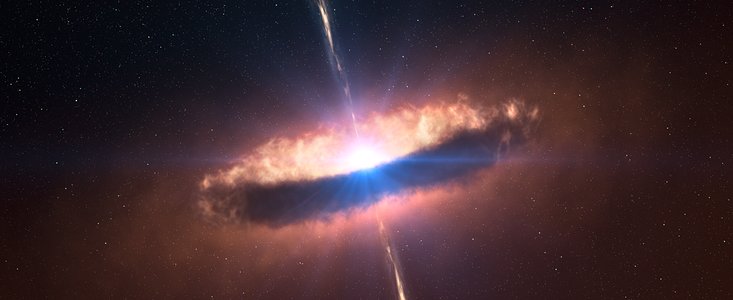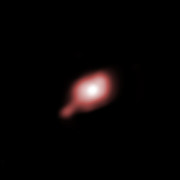Comunicato Stampa
Svelato il mistero della nascita delle stelle massicce
Tutte le stelle nascono nello stesso modo
14 Luglio 2010
Gli astronomi hanno ottenuto per la prima volta l’immagine di un disco di polvere che avvolge una stella massiccia appena nata, fornendo la prova diretta che la formazione delle stelle massicce avviene nello stesso modo delle loro sorelle più piccole. Questa scoperta, realizzata grazie ad una combinazione di telescopi dell'ESO, è descritta in un articolo di questa settimana di Nature.
"Le nostre osservazioni mostrano un disco che circonda una giovane stella di grande massa allo stadio embrionale, ora completamente formatasi", spiega Stefan Kraus, che ha guidato lo studio. "Si può dire che il bambino sta per nascere!"
Il team di astronomi ha focalizzato il proprio interesse su un oggetto conosciuto con il nome criptico di IRAS 13481-6124. La giovane stella al centro, una ventina di volte la massa del nostro Sole e con un raggio cinque volte superiore, ancora circondata dal suo bozzolo pre-natale, si trova nella costellazione del Centauro, a circa 10.000 anni luce di distanza.
Dalle immagini d'archivio ottenute grazie al telescopio della NASA Spitzer Space Telescope, nonché dalle osservazioni fatte con il telescopio submillimetrico da 12 metri APEX, gli astronomi hanno scoperto la presenza di un getto.
“È comune osservare i getti intorno a giovani stelle di piccola massa e generalmente indicano la presenza di un disco", dice Kraus.
I dischi circumstellari sono un ingrediente essenziale nel processo di formazione delle stelle di piccola massa come il nostro Sole. Tuttavia, non è noto se tali dischi siano presenti anche durante la formazione di stelle più massicce di dieci masse solari, dove la forte luce emessa potrebbe impedire alla massa di cadere nella stella. Per esempio, è stato ipotizzato che le stelle massicce potrebbero formarsi dalla fusione di stelle più piccole.
Al fine di scoprire e comprendere le proprietà di questo disco, gli astronomi hanno impiegato il Very Large Telescope Interferometer (VLTI) dell'ESO. Combinando la luce di tre dei telescopi ausiliari da 1.8 metri del VLTI con lo strumento AMBER, gli astronomi hanno potuto ottenere dati equivalenti a quelli che sarebbe possibile vedere con un telescopio avente uno specchio di 85 metri di diametro. La risoluzione ottenuta è di circa 2,4 milliarcosecondi, che è equivalente a cogliere la capocchia di una vite sulla Stazione Spaziale Internazionale, o più di dieci volte la risoluzione possibile con gli attuali telescopi spaziali ottici.
Ulteriori Informazioni
Questa ricerca è stata presentata in un articolo pubblicato questa settimana su Nature (“A hot compact dust disk around a massive young stellar object”, by S. Kraus et al.).
Il team è compostoda Stefan Kraus (Università del Michigan, USA), Karl-Heinz Hofmann, Karl M. Menten, Dieter Schertl, Gerd Weigelt, Friedrich Wyrowski, e Anthony Meilland (Max-Planck-Istituto per la Radioastronomia Bonn, Germania),Karine Perraut (Laboratorio d’Astrofisicadi Grenoble, Francia), Romain Petrov e Sylvie Robbe-Dubois (Università di Nizza Sophia-Antipolis/CNRS/Osservatorio della Costa Azzurra, Francia), Peter Schilke (Università di Colonia, Germania), e Leonardo Testi (ESO).
L’ESO (European Southern Observatory) è la principale organizzazione intergovernativa di Astronomia in Europa e l’osservatorio astronomico più produttivo al mondo. È sostenuto da 14 paesi: Austria, Belgio, Repubblica Ceca, Danimarca, Finlandia, Francia, Germania, Italia, Olanda, Portogallo, Spagna, Svezia, Svizzera e Gran Bretagna. L’ESO mette in atto un ambizioso programma che si concentra sulla progettazione, costruzione e gestione di potenti strutture astronomiche da terra che consentano agli astronomi di fare importanti scoperte scientifiche. L’ESO ha anche un ruolo preminente nel promuovere e organizzare cooperazione nella ricerca astronomica. L’ESO gestisce tre siti unici di livello mondiale in Cile: La Silla, Paranal e Chajnantor. A Paranal, l’ESO gestisce il Very Large Telescope, l’osservatorio astronomico nella banda visibile più d’avanguardia al mondo. L’ESO è il partner europeo di un telescopio astronomico rivoluzionario, ALMA, il più grande progetto astronomico esistente. L’ESO sta pianificando al momento la realizzazione di un gigantesco telescopio nell’ottico/vicino-infrarosso di 42 metri di diametro, lo European Extremely Large Telescope, E-ELT, che diventerà “il più grande occhio del mondo rivolto al cielo”.
Links
Contatti
Stefan Kraus
University of Michigan
USA
Tel.: +1 734 615 7374
E-mail: stefankr@umich.edu
Richard Hook
ESO
Garching bei München, Germany
Tel.: +49 89 3200 6655
E-mail: rhook@eso.org
Henri Boffin
ESO, La Silla Paranal and E-ELT Press Officer
Garching bei München, Germany
Tel.: +49 89 3200 6222
Cell.: +49 174 515 43 24
E-mail: hboffin@eso.org
Joerg Gasser (press contact Svizzera)
Rete di divulgazione scientifica dell'ESO
E-mail: eson-switzerland@eso.org
Sul Comunicato Stampa
| Comunicato Stampa N": | eso1029it-ch |
| Nome: | Protoplanetary disc |
| Tipo: | Milky Way : Star : Circumstellar Material : Disk : Protoplanetary |
| Facility: | New Technology Telescope, Very Large Telescope, Very Large Telescope Interferometer |
| Instruments: | AMBER, LABOCA, SABOCA |
| Science data: | 2010Natur.466..339K |
Our use of Cookies
We use cookies that are essential for accessing our websites and using our services. We also use cookies to analyse, measure and improve our websites’ performance, to enable content sharing via social media and to display media content hosted on third-party platforms.
ESO Cookies Policy
The European Organisation for Astronomical Research in the Southern Hemisphere (ESO) is the pre-eminent intergovernmental science and technology organisation in astronomy. It carries out an ambitious programme focused on the design, construction and operation of powerful ground-based observing facilities for astronomy.
This Cookies Policy is intended to provide clarity by outlining the cookies used on the ESO public websites, their functions, the options you have for controlling them, and the ways you can contact us for additional details.
What are cookies?
Cookies are small pieces of data stored on your device by websites you visit. They serve various purposes, such as remembering login credentials and preferences and enhance your browsing experience.
Categories of cookies we use
Essential cookies (always active): These cookies are strictly necessary for the proper functioning of our website. Without these cookies, the website cannot operate correctly, and certain services, such as logging in or accessing secure areas, may not be available; because they are essential for the website’s operation, they cannot be disabled.
Functional Cookies: These cookies enhance your browsing experience by enabling additional features and personalization, such as remembering your preferences and settings. While not strictly necessary for the website to function, they improve usability and convenience; these cookies are only placed if you provide your consent.
Analytics cookies: These cookies collect information about how visitors interact with our website, such as which pages are visited most often and how users navigate the site. This data helps us improve website performance, optimize content, and enhance the user experience; these cookies are only placed if you provide your consent. We use the following analytics cookies.
Matomo Cookies:
This website uses Matomo (formerly Piwik), an open source software which enables the statistical analysis of website visits. Matomo uses cookies (text files) which are saved on your computer and which allow us to analyze how you use our website. The website user information generated by the cookies will only be saved on the servers of our IT Department. We use this information to analyze www.eso.org visits and to prepare reports on website activities. These data will not be disclosed to third parties.
On behalf of ESO, Matomo will use this information for the purpose of evaluating your use of the website, compiling reports on website activity and providing other services relating to website activity and internet usage.
Matomo cookies settings:
Additional Third-party cookies on ESO websites: some of our pages display content from external providers, e.g. YouTube.
Such third-party services are outside of ESO control and may, at any time, change their terms of service, use of cookies, etc.
YouTube: Some videos on the ESO website are embedded from ESO’s official YouTube channel. We have enabled YouTube’s privacy-enhanced mode, meaning that no cookies are set unless the user actively clicks on the video to play it. Additionally, in this mode, YouTube does not store any personally identifiable cookie data for embedded video playbacks. For more details, please refer to YouTube’s embedding videos information page.
Cookies can also be classified based on the following elements.
Regarding the domain, there are:
- First-party cookies, set by the website you are currently visiting. They are stored by the same domain that you are browsing and are used to enhance your experience on that site;
- Third-party cookies, set by a domain other than the one you are currently visiting.
As for their duration, cookies can be:
- Browser-session cookies, which are deleted when the user closes the browser;
- Stored cookies, which stay on the user's device for a predetermined period of time.
How to manage cookies
Cookie settings: You can modify your cookie choices for the ESO webpages at any time by clicking on the link Cookie settings at the bottom of any page.
In your browser: If you wish to delete cookies or instruct your browser to delete or block cookies by default, please visit the help pages of your browser:
Please be aware that if you delete or decline cookies, certain functionalities of our website may be not be available and your browsing experience may be affected.
You can set most browsers to prevent any cookies being placed on your device, but you may then have to manually adjust some preferences every time you visit a site/page. And some services and functionalities may not work properly at all (e.g. profile logging-in, shop check out).
Updates to the ESO Cookies Policy
The ESO Cookies Policy may be subject to future updates, which will be made available on this page.
Additional information
For any queries related to cookies, please contact: pdprATesoDOTorg.
As ESO public webpages are managed by our Department of Communication, your questions will be dealt with the support of the said Department.





